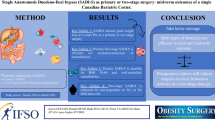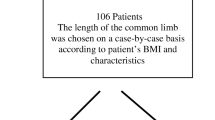Abstract
Background
Single-anastomosis duodeno-ileal bypass (SADI-S) is being proposed for obese patients with insufficient weight loss or weight regain after sleeve gastrectomy (SG), but limited information is available. The purpose of this study is to assess the safety and efficacy of SADI-S as a revisional surgery after SG, compared with standard duodenal switch (DS).
Methods
Unicentric cohort study including all patients submitted to SADI-S and DS after failed SG in a high-volume institution, between 2008 and 2020.
Results
Forty-six patients submitted to SADI-S and 55 to DS were included, 37.2 and 41.5 months after SG (p = 0.447), with initial BMI of 56.2 vs. 56.6 (p = 0.777) and 39.2 vs. 39.7 before revisional surgery (p = 0.675). All surgeries were laparoscopic. Clavien-Dindo > II complication rate was 6.5% for SADI-S and 10.9% for DS (p = 0.095), with no 90-day mortality. Follow-up at 2 years was available for 38 SADI-S’ and 38 DS’ patients, with total weight loss of 35.3% vs. 41.7% (p = 0.009), and excess weight loss 64.1% vs. 75.3% (p = 0.014). Comorbidities resolution for SADI-S and DS was: 44.4% vs. 76.9% for diabetes (p = 0.029) and 36.4% vs. 87.5% for hypertension (p = 0.006); with no differences for resolution of dyslipidemia (72.7% vs. 88.9%, p = 0.369) and obstructive sleep apnea (93.3% vs. 91.7%, p = 0.869). DS’ patients required more extra nutritional supplementation. Three SADI-S patients needed conversion to DS, two for biliary reflux and one for weight regain.
Conclusion
After a failed SG, revisional DS permits better weight control and diabetes and hypertension resolution than SADI-S, at the expense of higher supplementation needs.
Graphical abstract



Similar content being viewed by others
References
Marceau P, Biron S, Regent M, et al. Biliopancreatic diversion with gastrectomy as surgical treatment of morbid obesity. Obes Surg. 1991;1(4):381–7.
Gagner M, Deitel M, Erickson AL, et al. Survey on laparoscopic sleeve gastrectomy (LSG) at the fourth international consensus summit on sleeve gastrectomy. Obes Surg. 2013;23:2013–7.
Himpens J, Dobbeleir J, Peeters G. Long-term results of laparoscopic sleeve gastrectomy for obesity. Ann Surg. 2010;252:319–24.
Bohdjalian A, Langer FB, Shakeri-Leidenmühler S, et al. Sleeve gastrectomy as sole and definitive bariatric procedure: 5-year results for weight loss and ghrelin. Obes Surg. Springer New York LLC;. 2010;20:535–40.
Alvarenga ES, lo Menzo E, Szomstein S, et al. Safety and efficacy of 1020 consecutive laparoscopic sleeve gastrectomies performed as a primary treatment modality for morbid obesity. A single-center experience from the metabolic and bariatric surgical accreditation quality and improvement program. Surg Endosc. Springer New York LLC. 2016;30:2673–8.
Cheung D, Switzer NJ, Gill RS, et al. Revisional bariatric surgery following failed primary laparoscopic sleeve gastrectomy: a systematic review. Obes Surg. Springer Science and Business Media, LLC. 2014:1757–63.
Sánchez-Pernaute A, Rubio MÁ, Pérez N, et al. Single-anastomosis duodenoileal bypass as a revisional or second-step operation after sleeve gastrectomy. Surg Obes Relat Dis. Elsevier Inc. 2020;16:1491–6.
Merz AE, Blackstone RB, Gagner M, et al. Duodenal switch in revisional bariatric surgery: conclusions from an expert consensus panel. Surg Obes Relat Dis. Elsevier Inc. 2019;15:894–9.
Baltasar A, Bou R, Bengochea M, et al. Duodenal switch: an effective therapy for morbid obesity-intermediate results. Obes Surg. 2001;11(1):54–8.
Sánchez-Pernaute A, Rubio Herrera MA, Pérez-Aguirre E, et al. Proximal duodenal-ileal end-to-side bypass with sleeve gastrectomy: proposed technique. Obes Surg. 2007;17:1614–8.
Sánchez-Pernaute A, Herrera MAR, Pérez-Aguirre ME, et al. Single anastomosis duodeno-ileal bypass with sleeve gastrectomy (SADI-S). One to three-year follow-up. Obes Surg. 2010;20:1720–6.
Brown WA, Ponce De Leon Ballesteros G, Ooi G, et al. Single anastomosis duodenal-ileal bypass with sleeve gastrectomy/one anastomosis duodenal switch (SADI-S/OADS) IFSO position statement-update 2020. Obes Surg. 2021;31(1):3–25.
Balibrea JM, Vilallonga R, Hidalgo M, et al. Mid-term results and responsiveness predictors after two-step single-anastomosis duodeno-ileal bypass with sleeve gastrectomy. Obesity Surgery Springer New York LLC. 2017;27:1302–8.
Wu A, Tian J, Cao L, et al. Single-anastomosis duodeno-ileal bypass with sleeve gastrectomy (SADI-S) as a revisional surgery. Surg Obes Relat Dis. Elsevier Inc. 2018;14:1686–90.
Zaveri H, Surve A, Cottam D, et al. A multi-institutional study on the mid-term outcomes of single anastomosis duodeno-ileal bypass as a surgical revision option after sleeve gastrectomy. Obes Surg. Springer New York LLC. 2019;29:3165–73.
Finno P, Osorio J, García-Ruiz-de-Gordejuela A, et al. Single versus double-anastomosis duodenal switch: single-site comparative cohort study in 440 consecutive patients. Obes Surg. Springer. 2020;30:3309–16.
Cottam S, Cottam D, Cottam A. Sleeve gastrectomy weight loss and the preoperative and postoperative predictors: a systematic review. Obes Surg. Springer New York LLC. 2019:1388–96.
Sánchez-Santos R, Masdevall C, Baltasar A, et al. Short- and mid-term outcomes of sleeve gastrectomy for morbid obesity: the experience of the Spanish national registry. Obes Surg. Springer New York LLC. 2009;19:1203–10.
van Rutte PWJ, Smulders JF, de Zoete JP, et al. Indications and short-term outcomes of revisional surgery after failed or complicated sleeve gastrectomy. Obes Surg. 2012;22:1903–8.
Nevo N, Abu-Abeid S, Lahat G, et al. Converting a sleeve gastrectomy to a gastric bypass for weight loss failure—is it worth it? Obesity Surgery. Springer New York LLC. 2018;28:364–8.
Gautier T, Sarcher T, Contival N, et al. Indications and mid-term results of conversion from sleeve gastrectomy to Roux-en-Y gastric bypass. Obes Surg. 2013;23:212–5.
Risstad H, Søvik TT, Engström M, et al. Five-year outcomes after laparoscopic gastric bypass and laparoscopic duodenal switch in patients with body mass index of 50 to 60: a randomized clinical trial. JAMA Surgery. American Medical Association. 2015;150:352–61.
Deitel M, Gagner M, Erickson AL, et al. Third International Summit: current status of sleeve gastrectomy. Surg Obes Relat Dis. 2011:749–59.
Gagner M, Hutchinson C, Rosenthal R. Fifth International Consensus Conference: current status of sleeve gastrectomy. Surg Obes Relat Dis. Elsevier Inc. 2016:750–6.
Dapri G, Cadire GB, Himpens J. Laparoscopic repeat sleeve gastrectomy versus duodenal switch after isolated sleeve gastrectomy for obesity. Surg Obes Relat Dis. 2011;7:38–43.
Carmeli I, Golomb I, Sadot E, et al. Laparoscopic conversion of sleeve gastrectomy to a biliopancreatic diversion with duodenal switch or a Roux-en-Y gastric bypass due to weight loss failure: our algorithm. Surg Obes Relat Dis. Elsevier Inc. 2015;11:79–85.
Rebibo L, Fuks D, Verhaeghe P, et al. Repeat sleeve gastrectomy compared with primary sleeve gastrectomy: a single-center, matched case study. Obes Surg. 2012;22:1909–15.
Sethi M, Chau E, Jiang Y, et al. Long-term outcomes after biliopancreatic diversion with and without duodenal switch: 2, 5, and 10-year data. Surg Obes Relat Dis. Elsevier BV. 2015;11:S20–2.
Summerhays C, Cottam D, Cottam A. Internal hernia after revisional laparoscopic loop duodenal switch surgery. Surg Obes Relat Dis. Elsevier Inc.; 2016;12:e13–5.
Nemoto H, Tate G, Yokomizo K, et al. Gastric mixed adenoneuroendocrine carcinoma occurring 50 years after a gastroenterostomy with braun anastomosis. Case Reports in Oncology S. Karger AG. 2014;7:330–6.
Sitarz R, Maciejewski R, Polkowski WP, Offerhaus GJA. Gastroenterostoma after Billroth antrectomy as a premalignant condition. World Journal of Gastroenterology. Baishideng Publishing Group Co; 2012. p. 3201–6.
Topart P, Becouarn G, Sallé A, et al. Biliopancreatic diversion requires multiple vitamin and micronutrient adjustments within 2 years of surgery. Surg Obes Relat Dis. Elsevier Inc. 2014;10:936–41.
Surve A, Zaveri H, Cottam D, et al. A retrospective comparison of biliopancreatic diversion with duodenal switch with single anastomosis duodenal switch (SIPS-stomach intestinal pylorus sparing surgery) at a single institution with two year follow-up. Surg Obes Relat Dis. Elsevier Inc. 2017;13:415–22.
Hess DS, Hess DW, Oakley RS. The biliopancreatic diversion with the duodenal switch: results beyond 10 years. Obes Surg. 2005;15:408–16.
Acknowledgements
The authors would like to thank Dr. Núria Vilarrasa and Dr. Fernando Guerrero, from the department of Endocrinology and Nutrition, Bellvitge University Hospital, for their contribution in patients’ preoperative circuit and follow-up. They are also grateful to Ana Aguilar and John Hothersall for their English language assistance.
Author information
Authors and Affiliations
Corresponding author
Ethics declarations
Ethics Approval
This article does not contain any studies with human participants or animals performed by any of the authors.
Consent to Participate
Due to the retrospective nature of this study, formal consent was not required.
Conflict of Interest
Dr. Osorio and Dr. Pujol-Gebelli report personal fees from Ethicon Endo Surgery Inc., outside the submitted work. The rest of authors have no conflict of interest.
Additional information
Publisher’s Note
Springer Nature remains neutral with regard to jurisdictional claims in published maps and institutional affiliations.
Key Points
• Duodenal switch is more effective than SADI-S after a failed sleeve gastrectomy.
• Both revisional procedures are safe in experienced hands.
• Duodenal switch is associated to more extra supplementation needs.
Rights and permissions
About this article
Cite this article
Osorio, J., Lazzara, C., Admella, V. et al. Revisional Laparoscopic SADI-S vs. Duodenal Switch Following Failed Primary Sleeve Gastrectomy: a Single-Center Comparison of 101 Consecutive Cases. OBES SURG 31, 3667–3674 (2021). https://doi.org/10.1007/s11695-021-05469-9
Received:
Revised:
Accepted:
Published:
Issue Date:
DOI: https://doi.org/10.1007/s11695-021-05469-9




